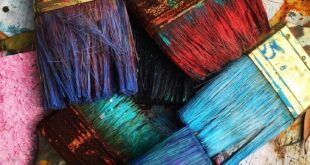20 Game-Changing Tips for Mastering Your Painting Skills
Are you looking to elevate your painting skills to the next level? Do you struggle with improving your style or developing new techniques? Fear not! Here are 20 amazing tricks to help you sharpen your skills and take your art to new heights.
1. Learn to observe
Observation is key in understanding how to transfer what you see onto your work of art. Start by studying still-life sets, landscapes, and portraits. Draw a variety of subjects including circles, squares, and triangles to improve your ability to see and depict shapes accurately.
2. Explore different styles of art
Explore a range of artistic styles, and develop an understanding of what works for your personality and character. Experiment with classical, abstract, or contemporary art styles until you find what you’re comfortable with.
3. Invest in quality materials
Quality materials can help provide long-lasting, professional results. The quality of your paints, brushes, and canvases can make a big difference in how a painting looks.
4. Set goals and challenges
Setting goals and challenges, teaches individuals to reach for their best selves. Find achievable objectives like ‘paint a still life in sixty minutes,’ and watch as you become more daring, creative, and confident in your abilities.
5. Join workshops and classes
Professional workshops and classes can help you learn insider tips from top-notch painters. With an abundance of online tutorials, you can virtually learn hands-on painting tricks from home.
6. Work with complementary colors
Complementary color schemes can suggest powerful visual contrast and exciting color vibrancy, add shimmer to your painting. Avoid colors that clash, like Yellow and Purple.
7. Experiment with texture
Techniques like palette, knife work and brushstrokes produce noticeable texture in artwork. Experiment with graphite and watercolor to provide dimens with a fresh aesthetic.
8. Practice color mixing
A deeper understanding of color mixing will induce nuanced tonal, value and chromatic changes, enabling you to create your unique palette efficiently.
9. Draw and sketch regularly
Sharpening your skills with drawing shapes and still-life setups provides a gallery express line to improving your final piece.
10. Study light and shadow ratios
Study and familiarize yourself with the changes that light makes on surfaces. Highlight everything from glow to areas doomed with heavy shadow.
11. Make collages or mixed media artwork
Mixed media involves a range of materials to produce depth and realism to are piece. Make use of textured paper, ink or stencils alongside conventional oil painting to give your painting overwhelming visual complexity.
12. Make acrylic paint markers
Create decoratively vibrant detailing by using a white paint highlighter to pop small areas.
13. Embrace your creativity
Bring your artistic intuition and mental conceptions to the artwork. Writ projects that challenge your imagination, and consider using your emotions as inspiration.
14. Practice direct painting
Increase the velocity at which you paint with uninterruptable vigour by using characteristics like brushstrokes and marks that can only come from fluid action.
15. Posture and Ergonomics
Sitting on uncomfortable postures for extended hours could lead to spinal ache, stiffness and sluggish physical reaction. Invest in comfortable carts where on your strain won’t affect your posture and thus, allow you next-level focus.
16. Study planar analysis
Human-made or unplanned compositions always follow certain photographic bookkeeping schemes that await framing and mastering. A camera to aid still shots is an ideal accessory that will assist in fundamentally realizing planar design in artwork.
17. Keep referencing
Regular reference-seating techniques applying art methodologies from feedback sessions on finished paintings. The technique also becomes an elementary enriching artwork, effectively gratifying as it enables consistent advancements in one’s pieces.
18. Regular breaks, holiday sessions deep-thinking activities
Whenever painting, remember to stand up and stretch-fit obligatory group fitness activities. Paint renewal sessions are great, as are exhilarating activities like hiking and brisk walking.
19. Keep a written works record
Setting a goal enhances great progress performance outcomes while keeping written works with guidance in coursework enables more success.
20. Develop connections and participate in arts organization networks
Network connections aid information retrieval, advancement and persistence towards a personal artistic endeavor. Practice sharing your artwork online, galleries or exhibits openly, emphasizing individualization/edby formatting and professional platforms.
These 20 painting tips are ideal for empowering budding or struggling artists wishing to develop their expertise by further understanding, highlighting, and developing creative production principles. With practice, you’ll develop truly unique and inspired painting skills that bring your vision to life. Happy painting!
 Mind Uncharted Explore. Discover. Learn.
Mind Uncharted Explore. Discover. Learn.




